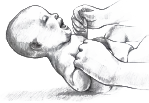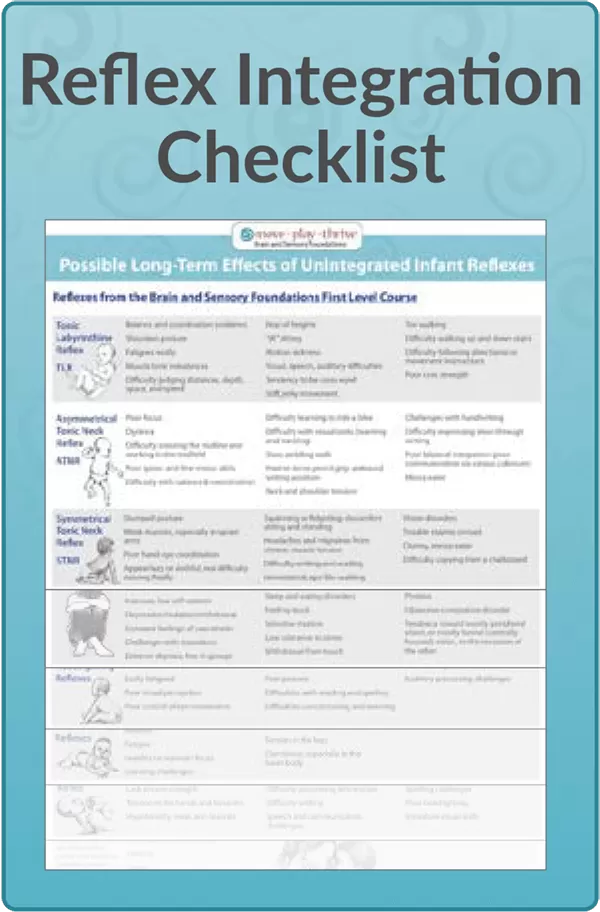Pull-to-Sit Reflex
 The Pull-to-Sit reflex is engaged when an infant lying in supine is pulled forward and up by the wrists. The pulling on the wrists and arms is meant to stimulates automatic bending of the arms, followed by flexion of the infant’s neck and abdomen, with the head lifting up in line with the torso. This active engagement of the arms, neck, and core help bring the baby safely up into a sitting position, and further develops the muscles in those regions.
The Pull-to-Sit reflex is engaged when an infant lying in supine is pulled forward and up by the wrists. The pulling on the wrists and arms is meant to stimulates automatic bending of the arms, followed by flexion of the infant’s neck and abdomen, with the head lifting up in line with the torso. This active engagement of the arms, neck, and core help bring the baby safely up into a sitting position, and further develops the muscles in those regions.
Pull-to-Sit works in conjunction with the Grasp and Palmar Reflexes as an infant learns the precise arm, hand, and finger movements required to grasp objects, put them in the mouth, and transfer them from hand to hand. This synergistic combination of reflexes sets the stage for later self-feeding.
In premature infants there is less engagement and pulling with the arms, as well as reduced ability to control the head. The Pull-to-Sit reflex is meant to be active at birth and integrated around 2 or 3 months of age. If the arms are not engaged in active flexion, or if the head lags behind the trunk, then developmental delays are indicated. Researchers have found that high-risk infants are more than two times as likely to display head lag as low-risk infants.
Children and adults with an unintegrated Pull-to-Sit reflex may have excessive tension in the forearms, shoulders, and neck due to compensating for the lack of foundational strength. In severe cases the elbows may be in a perpetually bent position, or individuals may find it difficult to intentionally bend and maintain flexion in the arms.
Possible Long-Term Effects of an Unintegrated Pull-to-Sit Reflex include:
- Developmental delays
- Lack of core strength
- Tension in the hands and forearms
- Hypotonicity, weak arm muscles
- Poor headrighting
- Poor gross and fine motor skills
- Difficulty writing, refusal to write
- Spelling challenges
- Difficulty processing information
- Immature visual skills
- Speech and communication challenges
- Amphibian Reflex
- Asymmetrical Tonic Neck Reflex
- Birth and Bonding
- Crawling Reflexes
- Crossed Extensor Reflex
- Facial-Oral Reflexes
- Fear Paralysis Reflex
- Feet Reflexes—Plantar & Babkinski
- Foot Tendon Guard
- Hand Reflexes—Grasp, Palmar, and Babkin
- Headrighting Reflexes
- Infant Torticollis
- Landau Reflex
- Moro Reflex
- Parachute Reflex
- Pull-to-Sit Reflex
- Spinal Galant Reflex
- Spinal Perez Reflex
- Symmetrical Tonic Neck Reflex
- Tonic Labyrinthine Reflex
Sources
Bradshaw, J., Shi, D., Federico, A., Klaiman, C., & Saulnier, C. (2023). The Pull-to-Sit task: Examining infant postural development in autism spectrum disorder. The Journal of Pediatrics, 253, 225-231.
Blomberg, H., & Dempsey, M. (2007). Rhythmic Movement Training: Levels 1, 2 and 3 [Training manual].
Masgutova, S. (2007). Integration of infant dynamic and postural reflex patterns: Neuro-sensory-motor and reflex integration method [Training manual].


